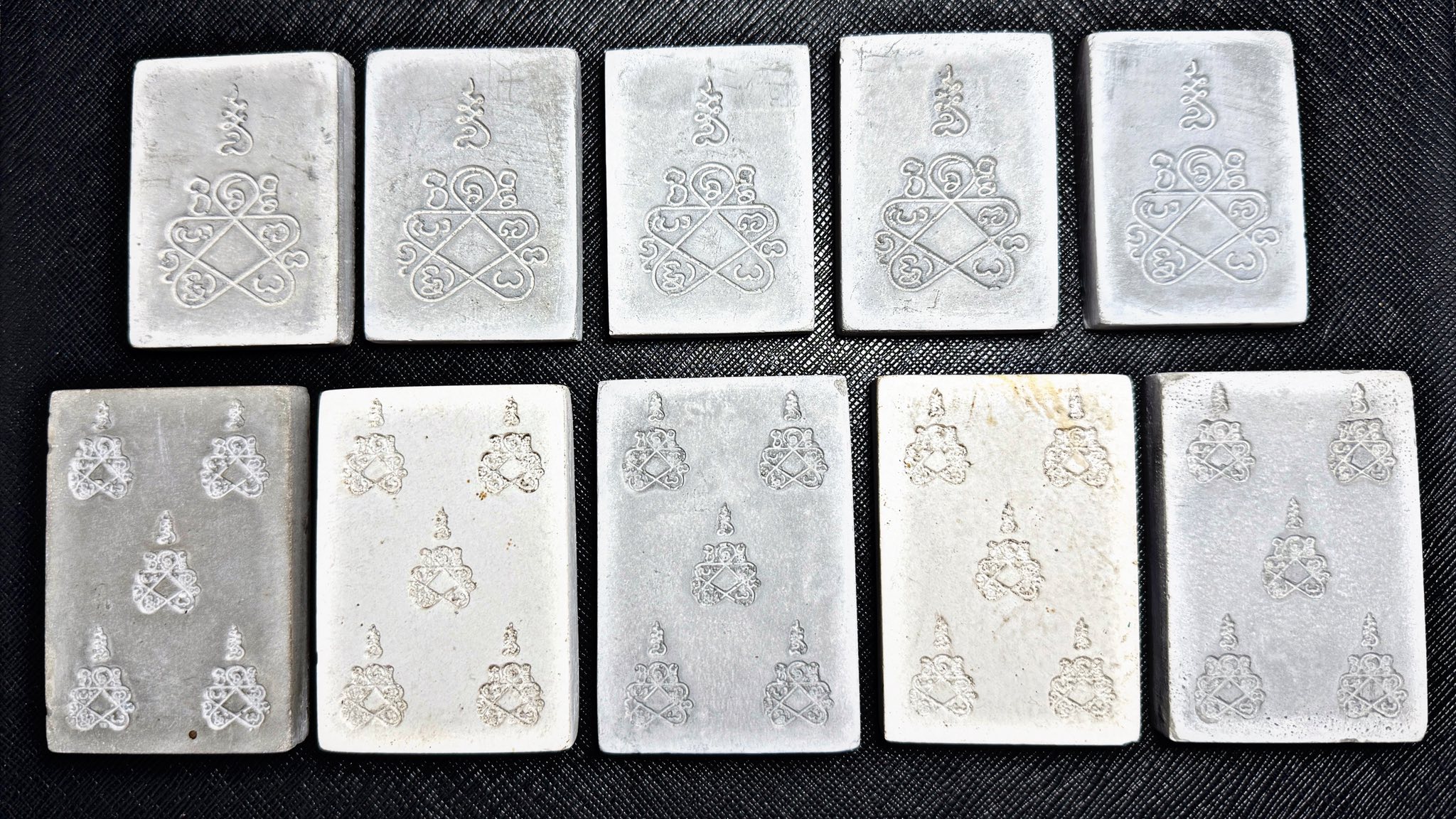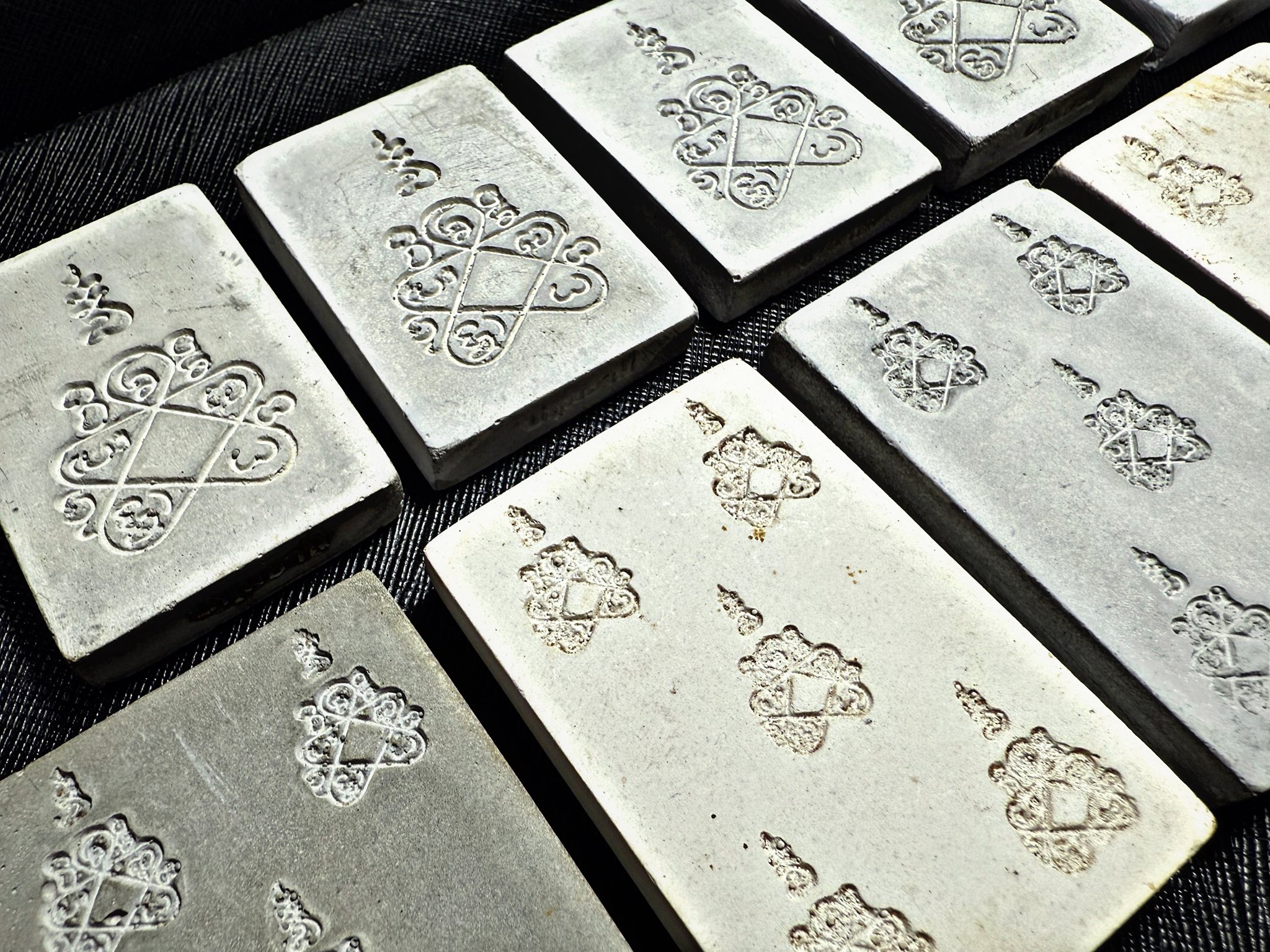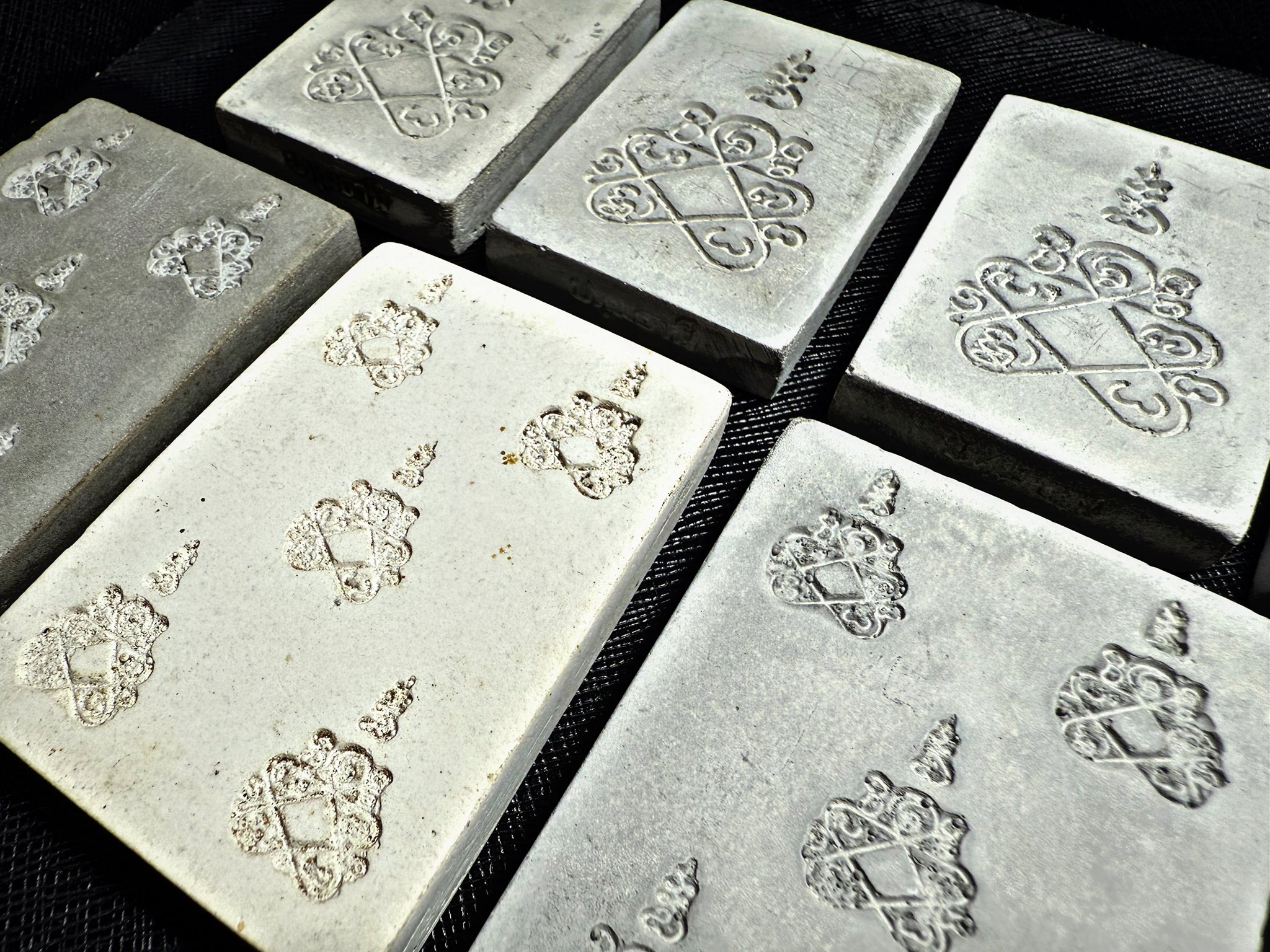


ก้อนยันต์ทำน้ำมนต์, “พระราชสิริวัชรรังษี” หลวงพ่อท่านเจ้าคุณชำนาญ อุตฺตมปญฺโญ, วัดชินวรารามวรวิหาร, จ.ปทุมธานี
ทำน้ำมนต์ดีนักแล อานุภาพของยันต์พระเจ้าห้าพระองค์ สายมอญรามัญนั้นเข้มขลังเหลือประมาณ
เป็นวัตถุมงคลที่หลวงพ่อชำนาญ ท่านได้สร้างไว้เพื่อช่วยเหลือสงเคราะห์ญาติโยม เมื่อปี 2556 ตั้งแต่สมัยที่ท่านยังจำวัดอยู่ที่วัดบางกุฏีทอง อย่างที่ทราบกันดีว่าในสมัยนั้นลูกศิษย์ลูกหาและผู้ที่มีความศรัทธาเป็นจำนวนมากต่างเดินทางไปที่วัด เพื่อขอให้ท่านเมตตาอาบน้ำมนต์ให้
ด้วยจำนวนคนที่ต้องการอาบน้ำมนต์นั้นมีมาก จนเกินกำลังที่ท่านเพียงคนเดียวจะสงเคราะห์ได้อย่างทั่วถึง ท่านจึงได้ทำก้อนยันต์ทำน้ำมนต์นี้ขึ้นมา เพื่อให้ผู้ที่ต้องการต้องการอาบน้ำมนต์หรือนำน้ำมนต์ไปใช้เพื่อเสริมขวัญและกำลังใจ สามารถทำน้ำมนต์เพื่อสงเคราะห์ตนเองที่บ้านได้อย่างสะดวก
ก้อนยันต์ทำน้ำมนต์นี้ มีมวลสารเป็นปูนเสกผสมกับผงพุทธคุณต่างๆตามสูตรเฉพาะของหลวงพ่อชำนาญ แต่ละก้อนจะมี "ยันต์ครูพระเจ้าห้าพระองค์" (ตำรับมอญรามัญ) ประทับไว้ เป็นยันต์ที่สื่อถึงพระพุทธเจ้าทั้ง ๕ พระองค์ที่อุบัติใน “ภัทรกัป” หรือ “กัปป์แห่งความเจริญ” ที่เรียกว่าภัทรกัป เนื่องมาจากเป็นกัปป์ที่มีจำนวนของพระพุทธเจ้าที่ทรงตรัสรู้ในภัทรกัปแห่งนี้มากที่สุดถึง ๕ พระองค์คือ พระกกุสันโธ, พระโกนาคมโน, พระกัสสโป, พระโคตโม และพระศรีอาริยเมตไตรโย เป็นกัปที่มีความเจริญรุ่งเรืองที่สุด ดังนั้นก้อนยันต์ทำน้ำมนต์นี้ถือเป็นการน้อมนำเอาพระพุทธคุณคาถามาประดิษฐานไว้ เพื่อยังความเจริญรุ่งเรือง โชคลาภ ให้บังเกิดขึ้นกับผู้ที่นำไปบูชาทุกคน
ก้อนยันต์ทำน้ำมนต์จึงมีพุทธคุณ มีความศักดิ์สิทธิ์ ดีนอกดีในเสร็จสรรพ เหมาะแก่การใช้เป็นหัวเชื้อทำน้ำมนต์ เพื่อใช้อาบกินแก้อาถรรพ์ เสนียดจัญไรทั้งปวงให้หมดไป เสริมสง่าราศีเสริมโชค เสริมดวง ทำสิ่งใดก็จักสำเร็จ ด้วยเหตุว่าความมงคลได้บังเกิดอยู่กับตัวแล้วนั่นเอง
ใช้ได้สารพัดตามใจนึก ขอบอกว่าได้ผลสมใจ อาทิเช่น ประพรมร้านค้าขายดีเป็นเทน้ำเทท่า ประพรมบ้านเรือนที่อยู่อาศัยก็ร่มเย็นเป็นสุข ประพรมเรือกสวนไร่นาพืชพันธุ์ธัญญาหารผลิดอกออกผล ประพรมรถยนต์พาหนะก่อนออกเดินทางก็แคล้วคลาดปลอดภัย หรืออธิษฐานประพรมได้ตามแต่ปรารถนา ใช้ทำน้ำมนต์ล้างหน้าตอนเช้า เสริมสง่าราศี เป็นสิริมงคล นำพาความสำเร็จ สมหวัง รุ่งเรืองในทุกๆวัน
จัดสร้างทั้งหมด2ขนาด:
ขนาดเล็ก = ยันต์ครูพระเจ้าห้าพระองค์ 1 ยันต์
ขนาดใหญ่ = ยันต์ครูพระเจ้าห้าพระองค์ 5 ยันต์
วิธีการใช้:
ให้หาภาชนะมาใส่น้ำ นำก้อนยันต์ทำน้ำมนต์วางในภาชนะนั้น แล้วจุดเทียน 1 เล่ม ธูป 3, 9, หรือ 16 ดอก ตั้งนะโม 3 จบ ระลึกถึงคุณพระรัตนตรัย ขอบารมีพระพุทธ พระธรรม พระสงฆ์ หลวงพ่อชำนาญ และครูบาอาจารย์ของท่าน แล้วจึงตั้งใจอธิษฐานบอกกล่าวตามที่ตั้งใจประสงค์ เสร็จแล้วจึงปักธูปเทียนในภาชนะที่เหมาะสมเช่นกระถางธูป (จะเป็นหน้าหิ้งพระ หรือกลางแจ้งก็ได้ ตามสะดวก) รอจนธูปหมด ก็สามารถนำน้ำมนต์มาใช้ได้ทันที
Mon-Raman Holy Water Block by "Phra Rajsiri Wachararangsi" Luang Por Than Chao Khun Chamnan Uttamapanyo, Abbot of Wat Chinwararam Worawihan (Royal Monastery), Pathum Thani Province.
Truly potent for consecrated holy water, the power of the Yantra of the Five Buddhas in the Mon-Raman tradition is profoundly intense and sacred.
This sacred object was created by Luang Por Chamnan in 2013 (B.E. 2556) with the intention of helping and supporting laypeople. At that time, he was still residing at Wat Bang Kudi Thong. As is well known, during that period many of his disciples and faithful followers would travel to the temple to request his blessing and receive holy water from him.
Due to the large number of people seeking this ritual, far more than he alone could manage, Luang Por Chamnan created the Mon-Raman Holy Water Block. This allowed devotees who wished to be blessed or use holy water for spiritual support and encouragement to conveniently perform the holy water ritual at home by themselves.
This Mon-Raman Holy Water Block is composed of consecrated lime mixed with various sacred powders according to a special formula unique to Luang Por Chamnan. Each block embedded with the "Five Buddhas Supreme Yantra", following the traditional Mon-Raman script. This sacred yantra represents the five Buddhas who appeared in the Bhaddakappa, also known as the “Auspicious Aeon” or “Era of Prosperity.” It is called Bhaddakappa because it is the aeon in which the highest number of Buddhas, five in total, have attained enlightenment. These are: Phra Kakusandha, Phra Konagamana, Phra Kassapa, Phra Gotama (the historical Buddha), Phra Metteyya (Maitreya), the future Buddha. This era is considered the most prosperous and spiritually rich. Thus, this Mon-Raman Holy Water Block serves as a vessel that enshrines the spiritual power and blessings of these enlightened beings. It is intended to bring prosperity, good fortune, and spiritual advancement to all who worship or use it.
The Mon-Raman Holy Water Block possesses powerful Buddha qualities (Phutthakhun) and sacred energy, both externally and internally. It is perfectly suited for use as a concentrated base to create holy water, which can be used for bathing or drinking to dispel misfortune, negative energies, and spiritual impurities. It enhances charm, luck, and destiny, helping one succeed in their endeavors, as auspiciousness is already present within oneself.
This sacred object is highly versatile and can be used in many ways, as one desires. It is known to be truly effective. For example: Sprinkling holy water around a shop brings flourishing business and abundant sales, Sprinkling it around the home brings peace, harmony, and happiness, Sprinkling it on farmland or crops encourages healthy growth and abundant yields, Sprinkling it on vehicles before travel ensures protection and safe journeys, Sprinkling it on products or goods enhances sales and customer attraction. Or, one may simply make a wish and sprinkle it as desired, according to personal intentions. Using the holy water to wash your face in the morning helps enhance your radiance, dignity, and auspiciousness, guiding you toward success, fulfillment, and prosperity each and every day.
How to Use:
Prepare a clean container and fill it with water. Place the Mon-Raman Holy Water Block into the container. Then light one candle and 3, 9, or 16 incense sticks. Begin by chanting “Namo Tassa” three times (Namo Tassa Bhagavato Arahato Samma Sambuddhassa), and mindfully reflect upon the virtues of the Triple Gem, the Buddha, the Dhamma, and the Sangha. Call upon the sacred blessings of Luang Por Chamnan and his lineage of spiritual teachers. With focused intention, make your personal wish or prayer according to your purpose. Place the incense sticks and candle in an appropriate holder, such as an incense pot, either in front of a home altar or in an open outdoor space, depending on your preference. Once the incense has completely burned out, the holy water is ready to be used.
Available In Two Sizes:
Small Size = Contains 1 Five Buddhas Supreme Yantra.
Large Size = Contains 5 Five Buddhas Supreme Yantras.